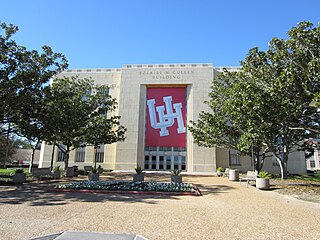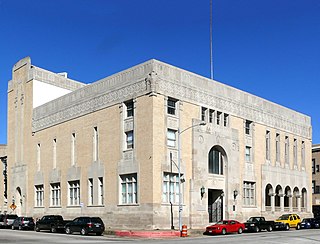
The JPMorgan Chase Tower, formerly Texas Commerce Tower, is a 305.4-meter (1,002-foot), 2,243,013-square-foot (208,382.7 m2), 75-story skyscraper at 600 Travis Street in Downtown Houston, Texas, United States. It is currently the tallest building in Texas and the South Central region of the United States, the tallest five-sided building in the world, the 29th-tallest building in the United States, and the 107th-tallest building in the world.

Downtown is the largest central business district in the city of Houston and the largest in the state of Texas, located near the geographic center of the metropolitan area at the confluence of Interstate 10, Interstate 45, and Interstate 69. The 1.84-square-mile (4.8 km2) district, enclosed by the aforementioned highways, contains the original townsite of Houston at the confluence of Buffalo Bayou and White Oak Bayou, a point known as Allen's Landing. Downtown has been the city's preeminent commercial district since its founding in 1836.

Montrose is an area located in west-central Houston, Texas, United States and is one of the city's major cultural areas. Montrose is a 7.5 square miles (19 km2) area roughly bounded by Interstate 69/U.S. Highway 59 to the south, Allen Parkway to the north, South Shepherd Drive to the west, and Taft to Fairview to Bagby to Highway 59 to Main to the east. Montrose neighborhoods include Cherryhurst, Courtlandt Place, Hyde Park, Montrose, Vermont Commons, North and East Montrose, Mandell Place and Winlow Place. Montrose is also less well known by the moniker Neartown, encompassing Superneighborhood #24.

The University of Houston is a public research university in Houston, Texas, United States. It was established in 1927 as Houston Junior College, a coeducational institution and one of multiple junior colleges formed in the first decades of the 20th century. In 1934, HJC was restructured as a four-year degree-granting institution and renamed University of Houston. In 1977, it became the founding member of the University of Houston System. Today, Houston is the fourth-largest university in Texas, awarding 11,156 degrees in 2023. As of 2024, it has a worldwide alumni base of 331,672.

The University of Houston System is a public university system in the U.S. state of Texas, comprising four separate and distinct universities. It also owns and holds broadcasting licenses to a public television station (KUHT) and a public radio station (KUHF).
KUHT is a PBS member television station in Houston, Texas, United States. Owned by the University of Houston System, it is sister to NPR member station KUHF. The two stations share studios and offices in the Melcher Center for Public Broadcasting on the campus of the University of Houston; KUHT's transmitter is located near Missouri City, in unincorporated northeastern Fort Bend County. In addition, the station leased some of its studio operations to Tegna-owned CBS affiliate KHOU from August 2017 to February 2019 when the latter's original studios were inundated by Hurricane Harvey.
KUHF is a public radio station serving Greater Houston metropolitan area. The station is owned by and licensed to the University of Houston System, and is operated by Houston Public Media, also known as Houston Public Radio. KUHF is housed in the Melcher Center for Public Broadcasting, along with KUHT, on the campus of the University of Houston. Local productions include The Engines of Our Ingenuity, Houston Matters, Town Square, and Next Question.

The Wortham Theater Center is a performing arts center located in downtown Houston, Texas, United States. The Wortham Theater Center, designed by Eugene Aubry of Morris Architects, was built out of private funds totaling over $66 Million. The City of Houston owns the building, and the Houston First Corporation operates the facility.

The architecture of Houston includes a wide variety of award-winning and historic examples located in various areas of the city of Houston, Texas. From early in its history to current times, the city inspired innovative and challenging building design and construction, as it quickly grew into an internationally recognized commercial and industrial hub of Texas and the United States.

The Roy G. Cullen Building is the oldest building on the present-day campus of the University of Houston. It is believed to be the first building on a campus of higher education in the United States with air conditioning. Construction for the building began in 1938, and was completed the following year.

Houston Music Hall was a 2,200-seat music venue located in Houston, Texas. The Music Hall opened in November 1937, at the same time as the Sam Houston Coliseum, which were built conjointly as the brainchild of Jesse H. Jones, and designed by Alfred C. Finn, his frequent collaborator. The project was financed by the Works Progress Administration at a cost of $1.3 million, and replaced Sam Houston Hall, which was a wooden structure that had been erected on the site for the 1928 Democratic National Convention and torn down in 1936.

Joseph Finger was an Austrian American architect. After immigrating to the United States in 1905, Finger settled in Houston, Texas in 1908, where he would remain for the duration of his life. Finger is best remembered for his role in bringing modern architecture to Texas.

Cullen Performance Hall is a concert hall located on the campus of the University of Houston in Houston, Texas. The hall, comprising the eastern half of the E. Cullen Building, was named in honor of Ezekiel W. Cullen, a former congressman for the Republic of Texas. The facility seats 1,544, and hosts music, opera, dance, theatrical events, and public lectures. Opening in 1950, the facility was designed by Alfred C. Finn.

Alfred Charles Finn was an American architect. He started in the profession with no formal training in 1904 as an apprentice for Sanguinet & Staats. He worked in their offices in Dallas, Fort Worth, and Houston. His credits during his tenure residential structures, but firm was a leader in steel-frame construction of skyscrapers.

Cullen Center is a skyscraper complex in Downtown Houston, Texas, United States. The complex is now managed by Brookfield Properties. Previously Trizec Properties owned all four office buildings. The complex includes the headquarters of the Houston Fire Department and KBR, and it formerly included the headquarters of Continental Airlines.

Scottish Rite Cathedral is a historic Scottish Rite Masonic building at 2128 Church Street in Galveston, Texas.

Mario Joseph Korbel was a Czech-American sculptor.

The Hugh Roy and Lillie Cullen Building is the central administration building of Southwestern University in Georgetown, Texas. Completed in 1900, the Cullen Building was declared a Recorded Texas Historic Landmark in 1962 and has been listed on the National Register of Historic Places since 1975, together with neighboring Mood-Bridwell Hall.

The Ezekiel Cullen House is a listed property on the National Register of Historic Places located in San Augustine, Texas. Augustus Phelps completed the structure in 1839 for Ezekiel Cullen. Hugh Roy Cullen contracted with Raiford Stripling to restore the house in 1952, and donated the property to the Ezekiel Cullen Chapter of the Daughters of the Republic of Texas.






















